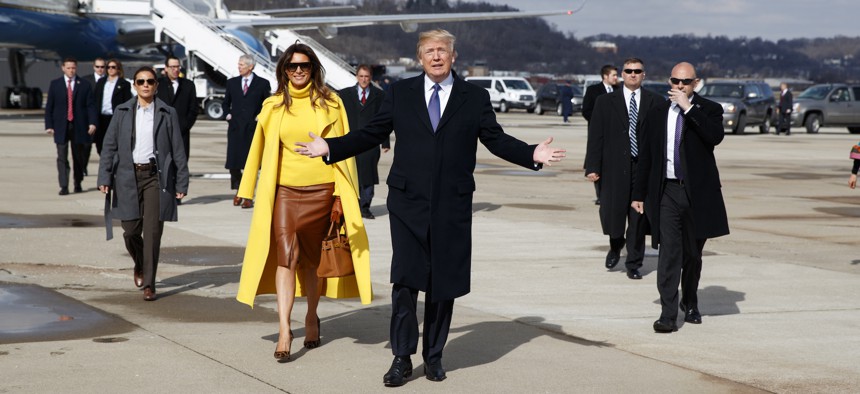Trump to Stump for Infrastructure—Again

President Trump and first lady Melania Trump walk to greet supporters after arriving at Cincinnati Municipal Lunken Airport, Monday, Feb. 5, 2018, in Cincinnati. Evan Vucci / AP File Photo

Connecting state and local government leaders
The president will highlight his public works plan in Richfield, Ohio on Thursday.
WASHINGTON — President Trump is set to make a case for his infrastructure proposal during a visit to northeast Ohio on Thursday.
But there are still no clear answers where federal dollars for the plan would come from. And White House officials are acknowledging that gaining congressional approval this year for a public works package like the one the president has proposed will be tough.
"I think the odds that pieces of this pass this year are very, very high," a senior administration official told reporters during a phone briefing Wednesday, according to a transcript of the call. "Will we get the entire bill through this year, that is more of a stretch."
The administration's continued focus on public works comes after the president last week signed a $1.3 trillion spending bill for fiscal year 2018 that lawmakers loaded up with a roughly $10 billion boost for infrastructure programs. But that hefty funding went to existing accounts, as opposed to new programs like those in Trump's plan.
The spending package promises to ratchet up U.S. deficits even further in the years ahead, which raises questions about how strong the appetite will be among lawmakers, especially budget hawks, for pumping more money toward infrastructure initiatives.
Trump's infrastructure plan calls for about $200 billion of federal spending, that would mostly go toward three new grant programs. The White House proposal also includes provisions focused on workforce development and cutting down project permitting and approval times.
"It's unlikely there will be one piece of legislation that will contain all these elements," one of the senior administration officials on Wednesday's call said, in reference to the proposal. "We hope to get a big chunk of the plan done this year," they added. "But whatever we're not able to get through this year, we'll take up again next year."
Trump has stressed the need for infrastructure investment throughout his time in office. Members of his cabinet and others in his administration in recent weeks have made efforts to promote the president's public works plan in Congress and at other venues.
White House officials on Wednesday's call said the administration is supportive of an approach that House Speaker Paul Ryan has described for passing multiple pieces of infrastructure legislation as opposed to one sweeping package.
When Ryan outlined this approach last month, some of the legislation he alluded to was on Congress's radar this year anyway, regardless of Trump's plan. For instance, legislation known as the Water Resources Development Act, or WRDA, which covers the Army Corps of Engineers and a reauthorization bill for the Federal Aviation Administration.
Key Republicans in Congress have shown enthusiasm for overhauling permitting and project approval guidelines. But any push on this front could easily stray into controversial territory.
Conservation groups and others have raised concerns that the changes the administration is seeking could undermine environmental protections. And the permitting and approvals in question are for not only bridges and roads but also projects like oil and gas pipelines.
Also on Wednesday, the White House Council of Economic Advisers released a report on the possible economic benefits of a new infrastructure program akin to what the president has proposed.
The report estimates a 10-year, $1.5 trillion program could add between 0.1 and 0.2 percentage points to average annual real growth in the nation's Gross Domestic Product—a measure of economic output. It also says the president's plan would likely lead to the employment 290,000 to 414,000 additional infrastructure workers, on average, over a decade. But it adds that these employment gains may be offset by losses elsewhere in the economy.
Whether the plan the White House has put forward can generate $1.5 trillion of investment is unclear and would depend on how much money states, localities and private investors put toward projects.
The report from the Council of Economic Advisers argues for using current infrastructure "more efficiently" by implementing policies such as "congestion pricing." An example of congestion pricing might be charging higher fees or tolls for using a busy road at rush hour.
Earlier in the week, the Committee for a Responsible Federal Budget, a nonprofit watchdog group, cautioned in an analysis that if new infrastructure spending is debt financed, as opposed to offset with some sort of "pay-fors" it could actually hurt GDP.
The group's analysis says that a "generic" $1 trillion package could increase GDP by an estimated 0.12 percent after two decades if offset with certain pay-fors. But the same package, if debt financed, would shrink GDP by 0.08 percent. (For a $200 billion plan, possible growth could be more than 0.02 percent with offsets, versus a nearly 0.02 percent decrease in GDP with a debt financed initiative.)
"Ramping up infrastructure spending without paying for it would not only worsen our already grim budget outlook, it would also undermine the pro-growth effects these proposals might have," the Committee for a Responsible Federal Budget says in its analysis.
The president has expressed an openness to raising the gas tax, which could help pay for additional transportation infrastructure spending.
But Ryan has ruled the idea out as a possibility for now. And, with an election in November, support in his caucus for hiking the tax is scant
Trump will make his remarks on Thursday in Richfield, Ohio at a training site for members of the International Union of Operating Engineers Local 18, according to the White House.
Bill Lucia is a Senior Reporter for Government Executive's Route Fifty and is based in Washington, D.C.

NEXT STORY: A better modernization strategy for cloud-obsessed agencies





